Isuzu D-Max pickup review (2025)
Fantastic safety, excellent road manners and superb off road - the Isuzu D-Max worth a look
PROS
- Agile and easy to drive
- Wide range of different versions
- Off-road capability improved again for 2025
- High quality and practical cab
- Strong safety kit
CONS
- Only one engine option
- Rivals have more power and torque
- Average fuel economy
- Average service intervals
- Refinement could still be better
Summary
The 2025 Isuzu D-Max pickup truck is a reliable workhorse that offers buyers plenty of choice and value. The current version was originally launched in 2021 but has already had a couple of updates - one in 2023 and another in 2025.
While the fundamentals have remained the same, it has gained a substantially improved interior and driving dynamics while adding class-leading levels of safety equipment making it one of the best pickup trucks you can buy.
The second-generation D-Max offers a strong blend of all-round usability without compromising the core attributes that make it such a successful working vehicle. This working element is often to the fore, with one useful addition to the 2025 update intended to further strengthen its off-road abilities. It now comes with the option of a new Rough Terrain mode, which is activated in the touchscreen menu and acts as an extension of the traction control system.
This sits alongside the D-Max's impressive figures - each version will tow 3.5-tonnes (3,500kg) and every version will easily carry more than 1.0 tonne (1,000kg) in payload. Yet you can now describe the higher-spec versions as nearly luxurious, and your family will be able to travel with you in greater comfort.
Is the 2025 Isuzu D-Max an all-new pickup truck?
As with the last update, no, the 2025 refresh is just that. There are some visual changes, there is some new equipment and a tweak to the safety kit levels. The big changes on the outside are a new grille, a revised bonnet, repositioned fog lights and updated headlights. These headlights are halogens for the lower trims and LEDs for the top two versions.
At the back, the tailgate has been redesigned with the top-end version now getting 'V-Cross' emblazoned across it in large letters. The bumper now comes with a step to help with access to the loading bay and all versions from the Utility double cab upwards get a tailgate damper. This means you can unlatch the tailgate and it will lower itself slowly, rather than banging down like a dead weight. There are more changes inside, too, with an updated design to the dashboard, revised seats and new upholstery. The information display is new, too.

The biggest change to the driving ability comes courtesy of a new Rough Terrain mode. This varies the power and braking levels sent to each wheel when it determines a lack of grip to enable it to get out of tricky spots.
Safety tweaks include upgraded cameras that can now look further ahead and wider than before, improving the Advanced Driver Assist Systems (ADAS) while there are still eight airbags are fitted as standard on double cab models.
The 164hp 1.9-litre turbodiesel carries over from the previous D-Max with no changes to it or its efficiency.
What were the changes to the D-Max in 2023?
The fundamental vehicle remains unchanged for 2025, though. In 2023 the chassis was made stronger and stiffer, while new suspension, electric power steering, and vastly improved bushings between the body and the frame brought upgrades to the driving experience at that update.
The 2023 D-Max is 30mm shorter than the previous one but has a larger load area and a larger passenger cabin, a 30mm higher ‘belt line’ and a 30mm increase in the wheelbase (the distance between the front and rear axles).
There are also new trim levels, though as before, Isuzu divides the D-Max range into Business, All-Purpose and Adventure categories.
The 2023 changes are really very minor, so there were no major update to the looks or the trim offerings.
Lots of choice
While Isuzu only offers one D-Max engine choice, in every other respect buyers have plenty of variables to choose from.
There are four well equipped standard trim levels. The Utility comes with different bodies while the All-Purpose range consists of the DL20, DL40 and V-Cross.
And there are three body types: Single Cab with two doors and two seats, Extended Cab with occasional rear seats and half-size rear doors, and Double Cab with four full doors and five seats. The Single Cab is only offered in Utility trim while you can get the Extended Cab in DL20 trim. The other models are all only Double Cabs.
You can read about the full dimensions and payload capability of each of these models on our dedicated Isuzu D-Max dimensions page.
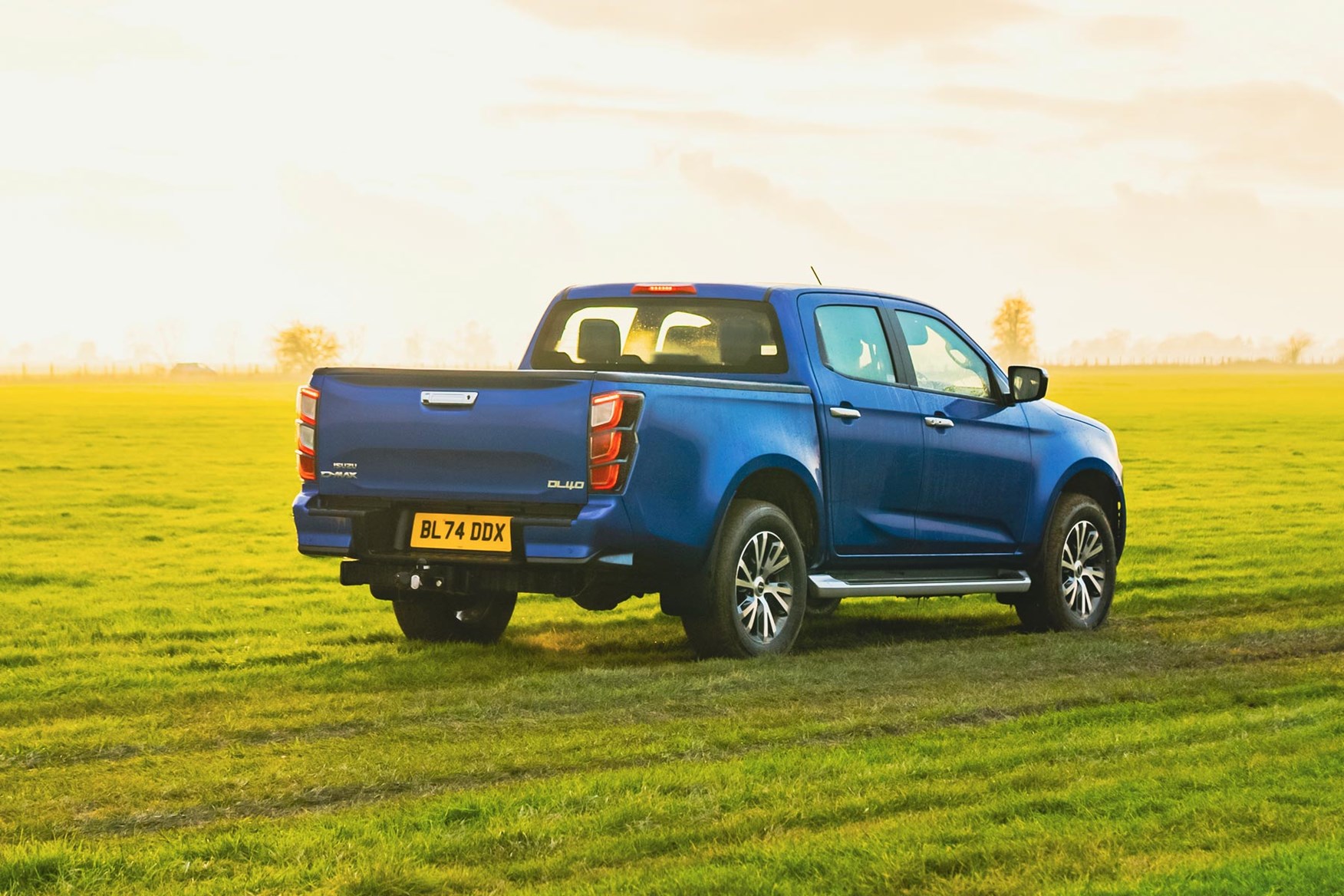
The Utility is the most basic-looking D-Max, with unpainted bumpers and steel wheels, but as you’ll find when you get to the costs section below, this doesn’t mean it’s poorly equipped.
Aimed at people who need a pickup purely for work, the Utility spec has easy-clean vinyl flooring and is available in all three body types.
The All-Purpose range consists of the D-Max DL20 and DL40. These both have body-coloured bumpers and 18-inch alloy wheels, and can be identified by different exterior trim detailing – the DL40 featuring a chrome finish to the grille, door mirrors and door handles, as well as a big jump-up in standard equipment.
The DL part of the name refers to the standard-fit rear differential lock; a first for the D-Max, this is a button-activated mechanical device that makes both rear wheels turn together – useful for slippery off-road situations, especially when one of the rear wheels is off the ground…
The V-Cross was once a special edition and is now a core part of the range. However, there are often special editions in the D-Max range. Isuzu, like most pickup makers, is very fond of special editions. The Mudmaster and Basecamp are two examples of that, as seen below.
Targeting lifestyle buyers, the V-Cross has all the toys plus gun metal exterior detailing. The V-Cross automatic is expected to be the most popular individual variant of the D-Max.
Five-star Euro NCAP rating
This D-Max was the first pickup to be awarded a five-star Euro NCAP crash test rating, although others have since followed suit. This result came in 2022, though, and the testers are finding ever more ways to be stringent, but Isuzu has continued to add more safety kit to the D-Max range.
You can find more details about this in the Safety section below, but in order to achieve such a high score, the D-Max doesn’t just need to crash well, it also needs to be packed with lots of Advanced Driver Assist Systems (ADAS) – technology that's supposed to help you avoid the crash in the first place.
Going further, all Double Cab models have eight airbags, including an unusual centre airbag, plus a rear radar system that actively prevents accidents by stopping you backing out of a parking space into on-coming traffic or changing lanes if there’s a vehicle in your blindspot. Single Cab and Extended Cab don’t get the radar, but they do get seven airbags.
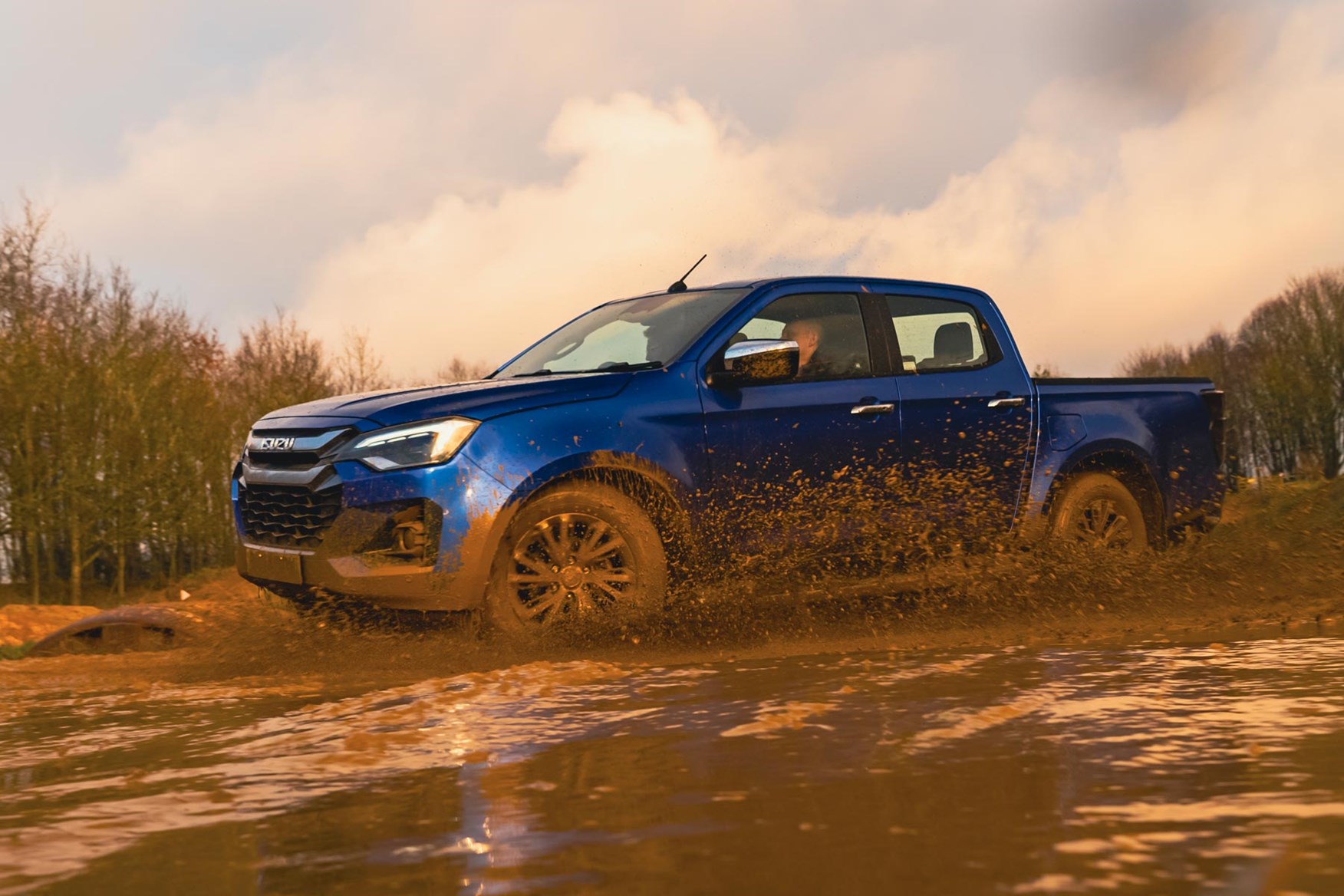
As for convenience, air-conditioning, DAB radio, Bluetooth, automatic lights and wipers, a six-way adjustable driver’s seat with lumbar support, and remote locking are standard on every D-Max.
Isuzu D-Max rivals
The number of competitors in the UK pickup market has started to rejuvenate once again, after a slight dip in the number available. The launch of the new Ford Ranger and Volkswagen Amarok was notable, with the former being named our Pickup of the Year in 2024 and 2025. The VW isn't far behind, as the two models were co-developed in a partnership between the two brands.
The Toyota Hilux is the other strong contender, while the KGM Musso is a value-led rival to the D-Max.
So although there are fewer pickups to choose from than there once were, they all offer tough alternatives to the D-Max. However, this is a pickup with a loyal following of existing owners, who will likely see their own feedback in the improvements Isuzu has made, while the upgraded safety, comfort and ease of use is sure to bring new customers the Isuzu’s way.
Verdict: is the Isuzu D-Max any good?
This review goes into much further detail, but cutting to the chase, the new D-Max is every bit as worthy of your consideration as those rivals.
While it may not be quite as polished to drive as the latest Ranger or Amarok and now substantially down on power compared with the Hilux, the D-Max is a thoughtfully conceived and very well executed extension of everything that was already good about this pickup, and one that can now play the lifestyle card much more convincingly.
Skip to our full verdict on...
- Vastly improved suspension, steering and comfort
- Same proven but not overly powerful engine
- Increased off-road capability, very confidence inspiring
Historically the D-Max has always been very much a working truck – and as such you expected the ride comfort to be a bit rough and ready, and for the steering to take a bit of effort. Over the years the D-Max has become more user-friendly, and brings great improvements in both areas.
This benefits the on-road driving experience in particular – though given it can still carry a tonne in the back, don’t go expecting it to feel just like a car. The 2025 update brings a new mode to benefit the off-road performance too, although it doesn't impact anything mechanical so the ride and steering is unchanged.
Steering and suspension
In 2021, Isuzu upgraded the chassis, giving it larger rails and an additional cross member, making it stronger. This allows the revised suspension to work more effectively. This brought about less body roll, improved stability and greater agility. The D-Max is rather deft to drive as pickups go, with sharp, predictable and nimble responses.
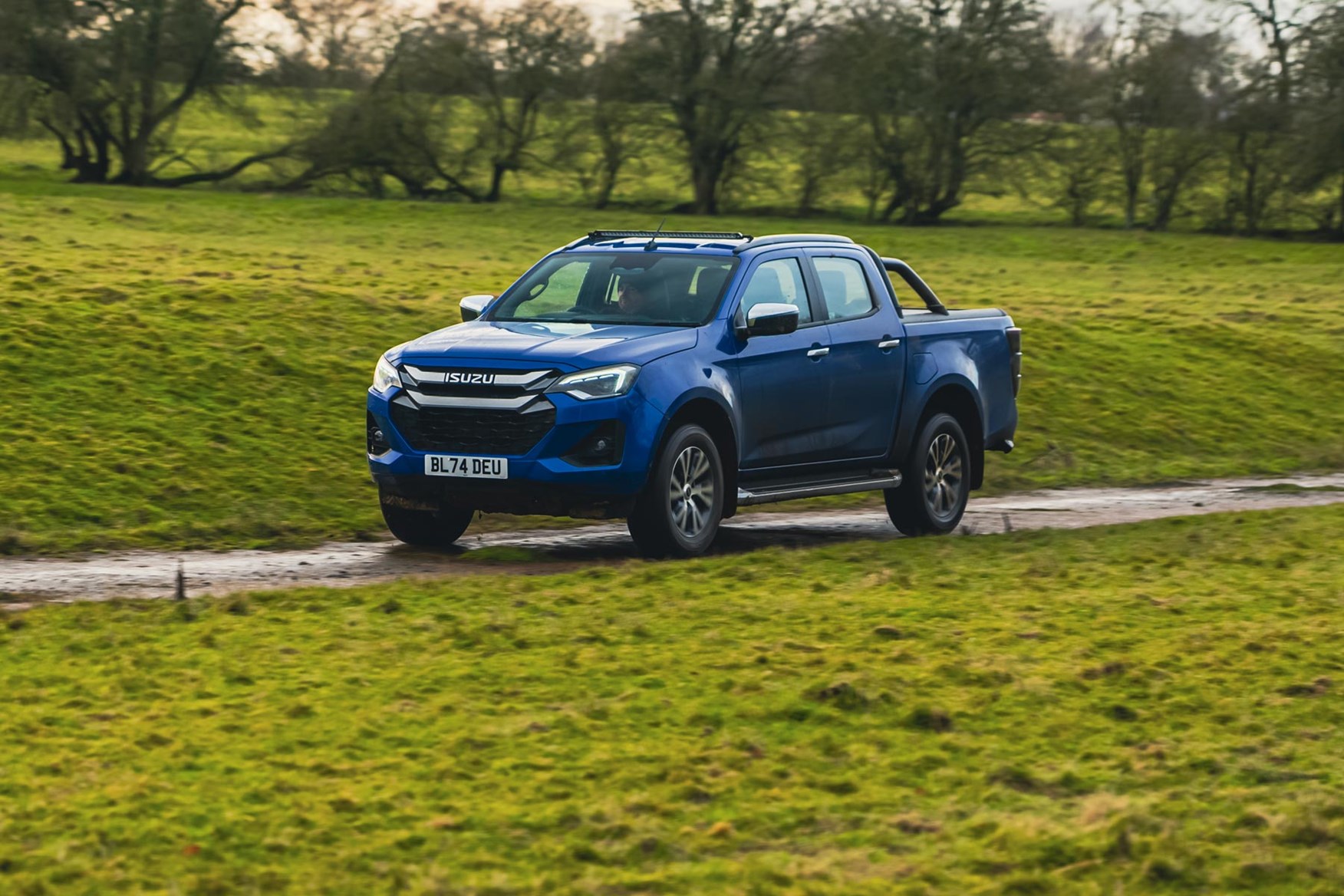
The electrically assisted power steering (EPAS) helps. It’s a speed sensitive system, so at low speeds it’s easy to turn the truck, with the weighting gradually increasing as you go faster.
We found this very natural in its operation, and although there’s a reasonably large dead-spot in the straight-ahead position – not uncommon for EPAS – we were quickly comfortable with how the available feedback gelled with the pickup’s cornering and general handling. As an added bonus, the EPAS transfers far less road shock from bumpy surfaces back to your hands.
The D-Max’s turning circle is 12.5 metres, kerb-to-kerb.
Ride comfort
This is good, but not quite dazzling – and an area where the latest Ford and VW rivals very much have an edge. The higher spec Double Cab models do certainly deal with bumps and potholes very adroitly, helping you to drive quickly with confidence.
Changes to the rear suspension leaf spring design and the shock-absorber mounting points are key to this, aided and abetted by the new design of ‘chassis cab mounts’ – the rubber bushings between the frame and the body – which absorb greater levels of noise, vibration and harshness (NVH).
However, it’s not a miracle cure. And compared with a car or SUV, you and your passengers are going to be bounced around somewhat more.
The bumping and bouncing increases as the number of doors decreases – so you’ll find an unladen Extended Cab choppier than a Double Cab, while the Single Cab feels like a motor-driven pogo stick at times. The back of both variants will calm down when some load has been added, so keep that in mind.
Engine, transmissions and speed limits
The engine is the same 1.9-litre single-turbo diesel that was introduced into the previous D-Max range back in 2017. There were some concerns at the time because, although power increased slightly to 164hp, torque fell from 400Nm to 360Nm, and buyers were worried this would dent the D-Max’s legendary towing capability.
This hasn’t turned out to be the case, and the latest generation D-Max tows the same 3.5-tonne maximum as the one that went before. However, there is no ignoring that all its rivals produce more torque – with the Ranger and the Hilux now offering as much as 500Nm. And upwards of 200hp.
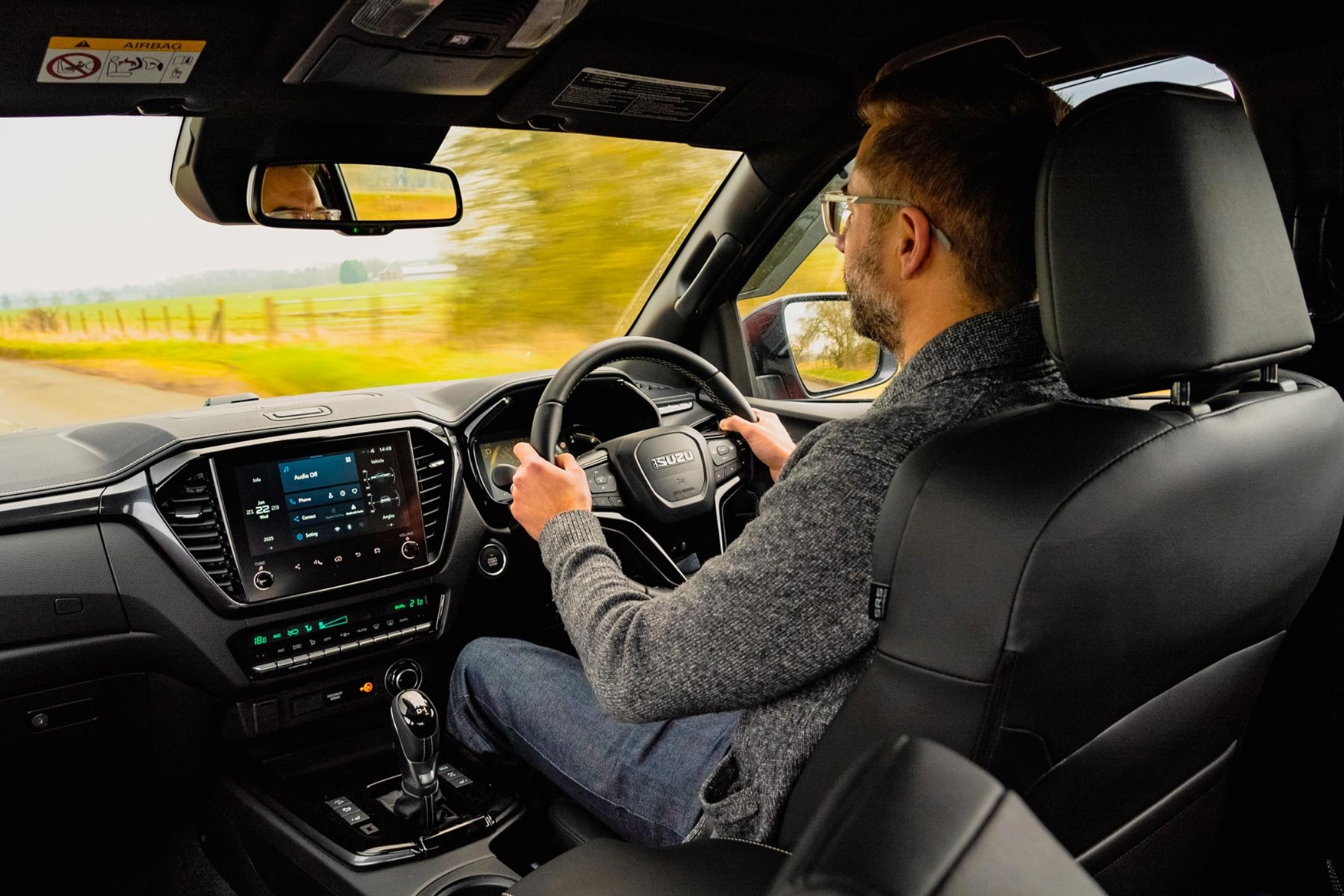
Speaking of the Hilux, the D-Max is available with the exact same six-speed Aisin automatic transmission – which is fine in terms of smoothness and swiftness, though some way behind the spread of ratios offered by the Ranger’s 10-speed auto.
The standard D-Max gearbox is a six-speed manual. This isn’t tough to use at all by pickup standards, though the enhancements Isuzu has made to the shift action are at least matched by the manual gearboxes in the Ranger and the Hilux now, so the D-Max doesn’t pull out any advantage here.
Still, previous D-Max owners will surely appreciate the difference. Especially as it now has a lock-out to prevent you accidentally selecting reverse instead of first gear.
The small engine does feel and sound like it is a bit strained at times, but this is a sensory thing as much as anything and it is never actually that lacking. It can tow well enough, keep pace on the motorway and has enough low-down pull, it might just require a bit of recalibration when it comes to what you are used to hearing and feeling.
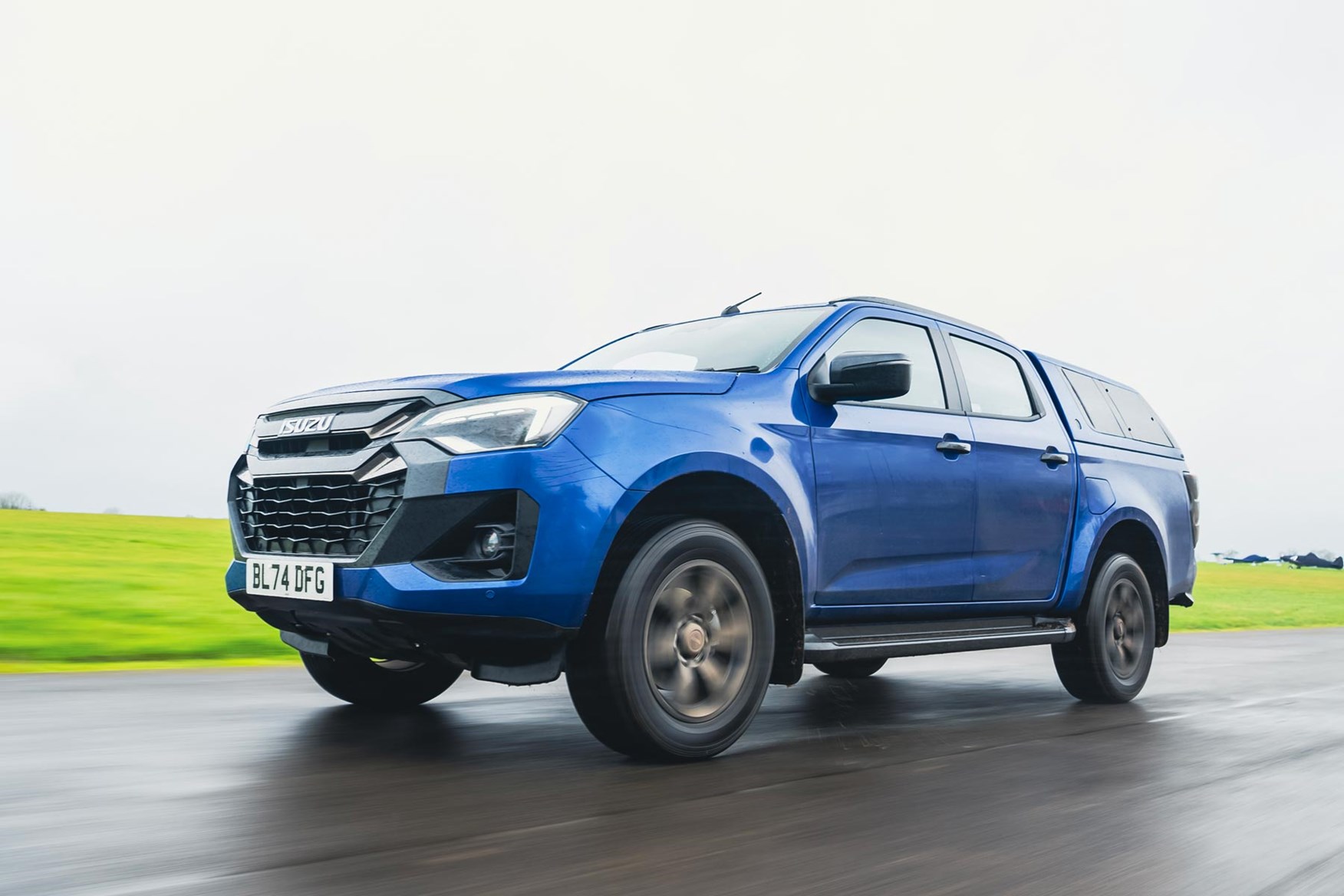
The D-Max does have an advantage when it comes to legal speed limits. Every version weighs less than the 2,040kg threshold for dual purpose vehicles, meaning the fancy lifestyle double cab models are allowed to travel at the same speeds as cars on single and dual carriageways.
This is not the case for its Ranger and Hilux rivals, which have all that extra muscle under the bonnet but are legally obliged to travel more slowly. Top speed for the D-Max is 112mph, and 0-62mph takes 12.7 seconds with the manual gearbox, 13.0 seconds with the automatic.
Every D-Max comes with selectable four-wheel drive (4x4) as standard – except the very cheapest Utility Single Cab, which is rear-wheel drive only (4x2).
A four-wheel drive Single Cab is available should you need maximum load length and the extra off-road traction.
Off-road capability
This is the big change for the 2025 update, but the new feature is not a physical update - the actual vehicle is much the same as before. Instead there is a new mode that can be accessed through the touchscreen. This is a Rough Terrain Mode and is of most use in low-grip situations. It works with the traction control and monitors the amount of grip that each wheel has and allocates more or less power by using the throttle and the brakes. The theory is that it will stop a wheel from spinning away and allow one with more grip to ease the vehicle forwards.
It certainly helped us get up some more slippery inclines on our test route around a very wet off road course. It wasn't totally infallible as the laws of physics still apply - we had to roll back down and take another run up on at least one occasion - but it does boost the D-Max's capabilities.
The stiff chassis helps with the off-road abilities, as does the rear suspension, which allows greater axle articulation to better deal with off-set obstructions. But there is more to it than that.
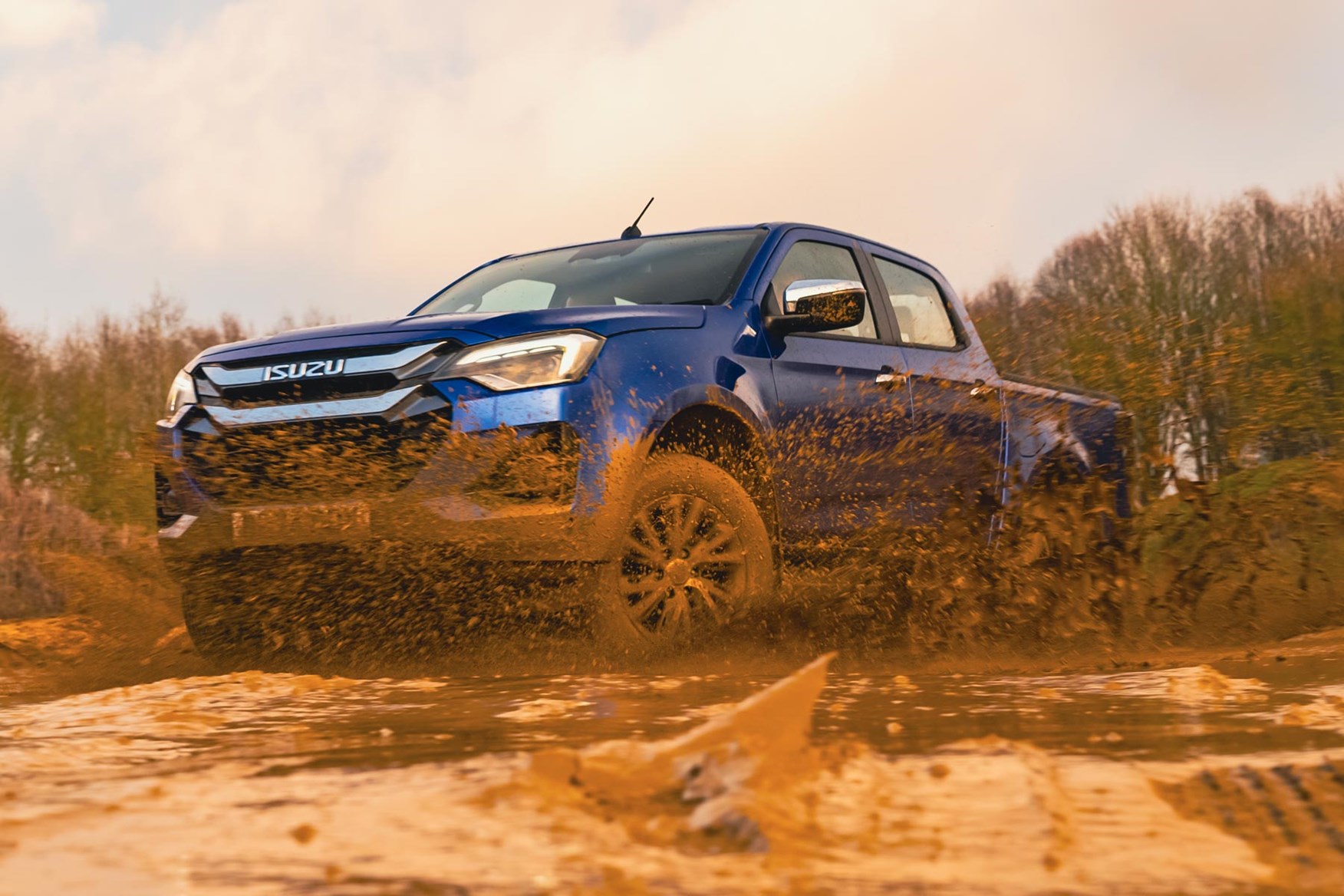
Every version with four wheel drive comes with a lockable rear differential, the four-wheel drive system engages quickly, and the underbody protection has been extended to better shield vulnerable parts from cross-country excursions.
Further off-road assistance comes from the standard-fit hill descent control and hill start assist – though neither these nor any of the other electronic aids work when the diff-lock is activated. Fortunately, if you forget to switch it off when rejoining the road, the locker is disabled automatically once you reach 19mph.
The selectable four-wheel drive has three modes:
- 2H high-range rear-wheel drive – the default setting for road use and for maximum fuel economy
- 4H high-range four-wheel – for moderate off-roading and particularly slippery roads (don’t use it on-road in the dry)
- 4L low-range four-wheel drive – a lower ratio gearing mode that gives you better control and traction for more treacherous off-road situations
It’s a ‘shift-on-the-fly’ system, which means you can swap between 2H and 4H via the dashboard-mounted rotary knob on the move up to around 60mph; 4L changes the gearing so much you need to stop and pop the clutch – or select neutral if in an auto – before rotating the dial to that position. All of this really does work much faster than before.
The hill descent control and diff-lock are activated by buttons on the centre console.
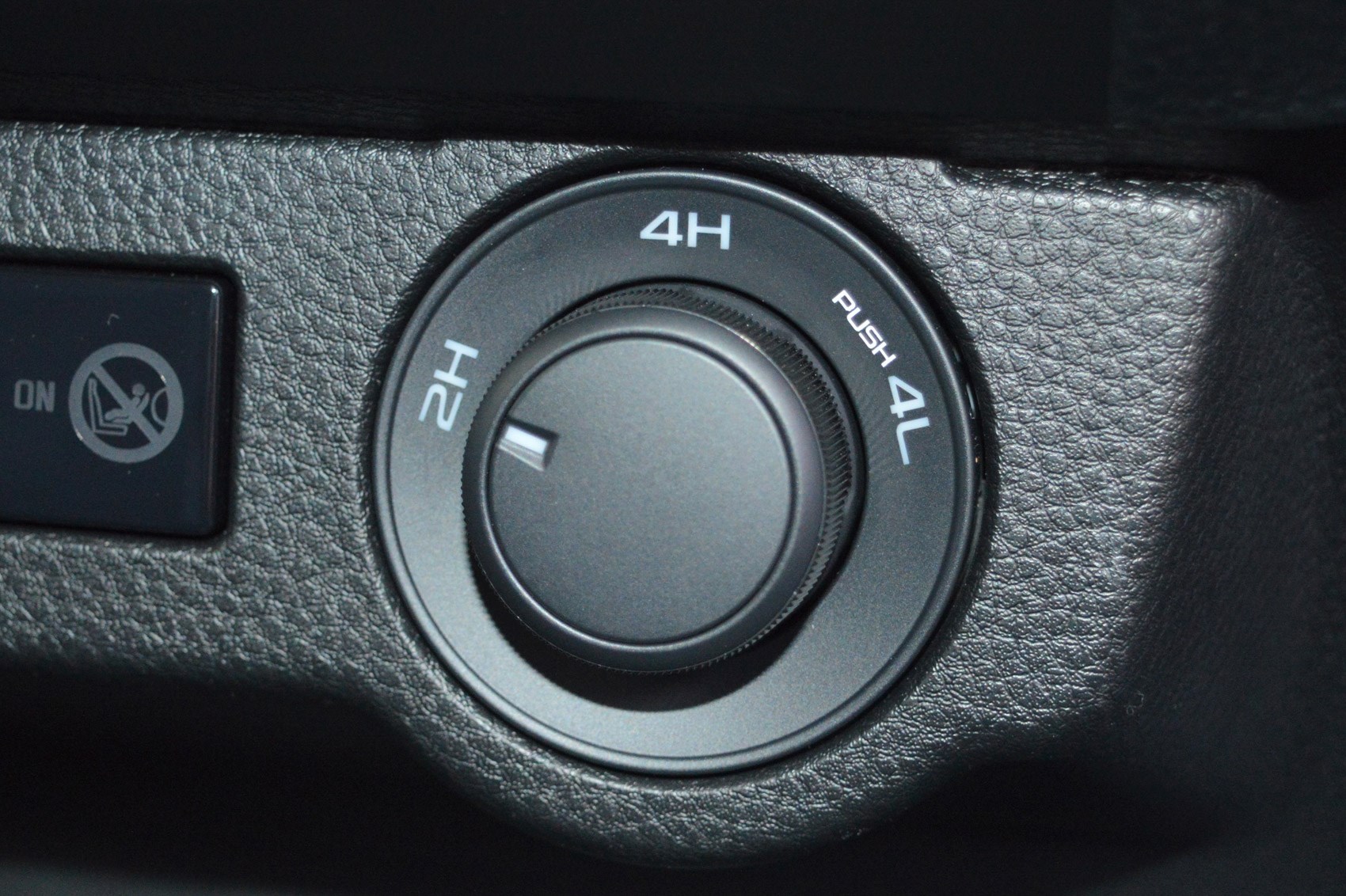
Everything works very effectively. We've had the chance to test each of the off-road functions on various occasions, with challenges including side-angle ascents and descents, soft sand, boggy mud and steep hills.
Not the most arduous off-road activity we’ve ever faced, but the D-Max breezed through every impediment in a highly confidence inspiring manner – the electric steering making light work of these manoeuvres as well.
- Much better interior design and quality
- Lots of clever practicality features
- New screen with more connectivity
From the way it looks to the way it feels beneath your fingers, the cabin is another area of enormous improvement over the previous D-Max.
There are some differences between the dashboard design of the basic Utility models and the rest of the line-up – the Utility versions also being the only ones to get easy-clean vinyl flooring, something the UK importer pays extra for on these models because it knows it’s appreciated by the Utility range’s customers.
Utility and DL20 versions get a full-colour 4.2-inch information display in the instrument cluster, with multiple menu screens that are controlled via buttons on the steering wheel, while on the DL40 and V-Cross models this becomes a 7.0-inch display. The main central screen has been upgraded too - the lower models get an 8.0-version while V-Cross gets a 9.0 equivalent. All versions now have wireless Apple CarPlay and Android Auto too. Fully integrated into the dashboard, these screens have none of the after-thought look that some ‘tablet-style’ infotainment systems do.
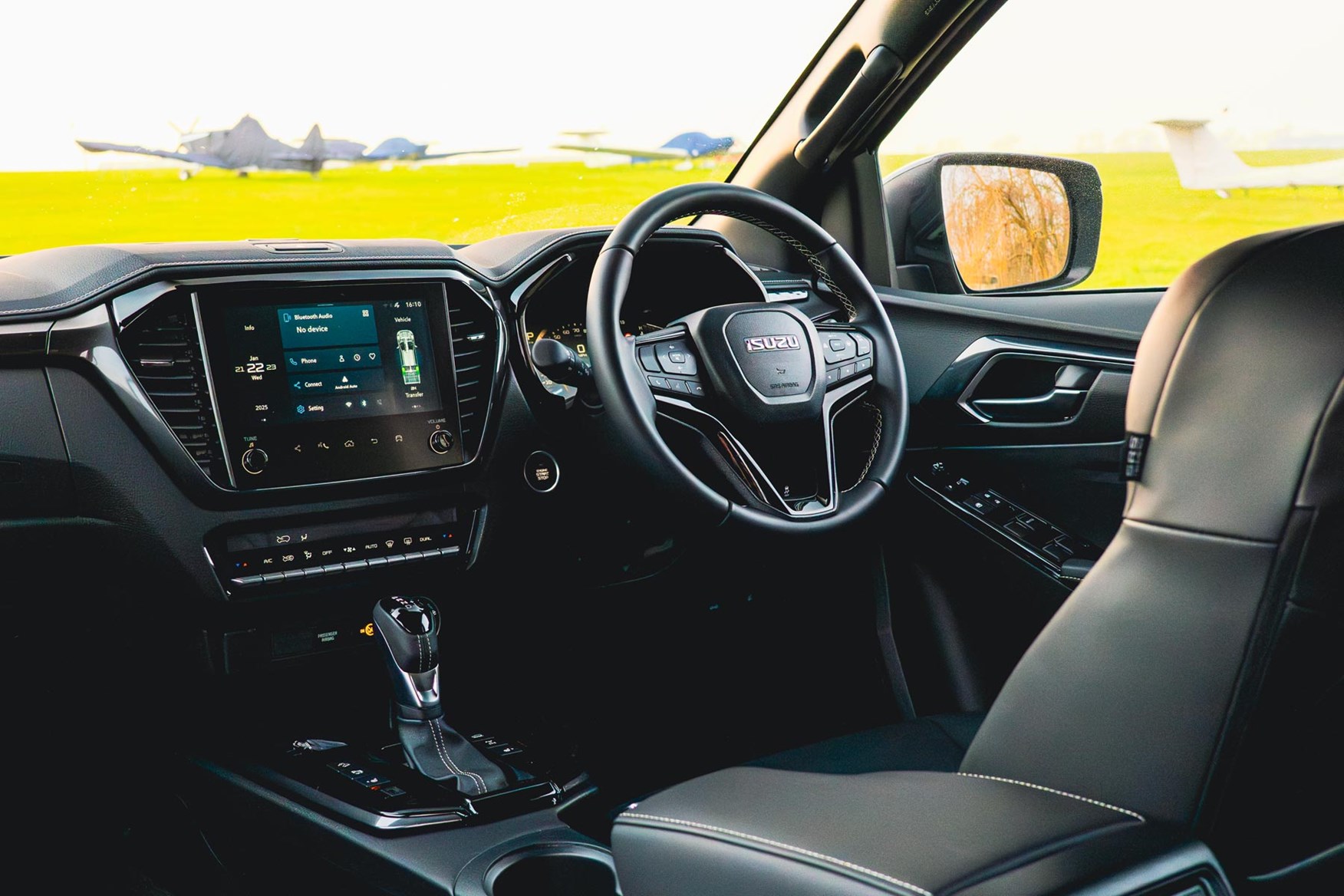
Move above Utility grade, and things start to look very appealing. The DL20 gets heavily bolstered heated seats in a technical fabric, for example, but shift up to DL40 and you get leather seats and steering wheel with kit such as keyless entry and start.
Comfort and refinement
Little has changed in terms of layout in for the latest D-Max update, but it was a solid and comfortable cabin anyway. The seats are made of appealing materials and even the entry-level gets six-way adjustment as standard for the driver plus lumbar support. It is a lot easier to get comfy behind said wheel than in previous models.
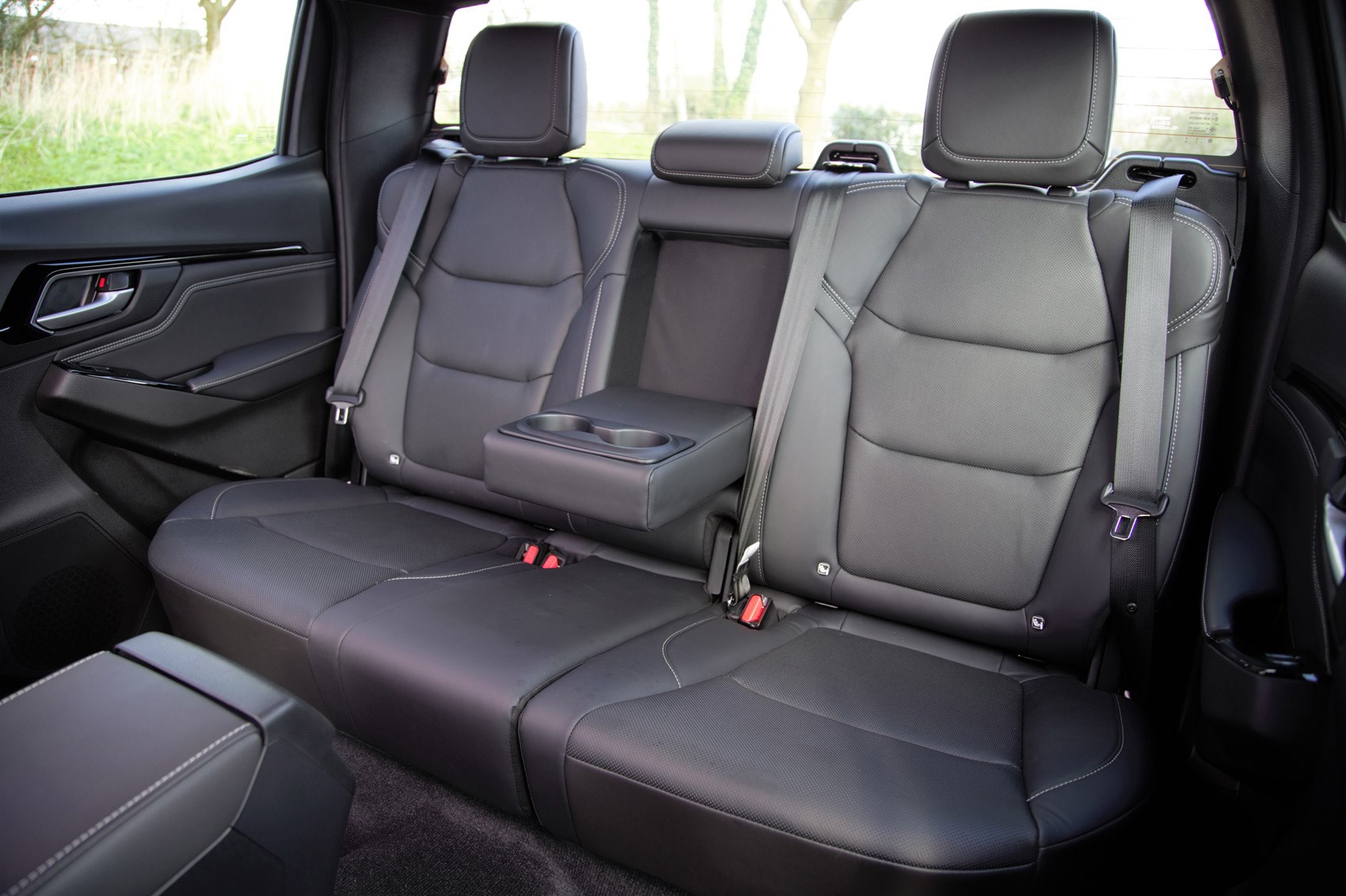
Double Cab versions have a rear seat-back angle that has some angle to it rather than being bolt upright and there’s a good amount of legroom, making it truly spacious. All but the Utility models come with rear heating ducts, the DL40 and V-Cross benefiting from a rear ventilation control panel.
Refinement is good, with almost all in-cabin vibration now eliminated. The engine is still quite gruff and vocal, and though it does calm down once warm you will still hear its determined diesely-ness whenever you need to accelerate hard.
Practicality
Pickups often get accused of having limited in-cab storage space compared with vans, but the D-Max has plenty of cup-holders, cubbies and other storage areas.
We particularly like the substantial pull-out drawers with integrated cup-holders on either end of the dashboard, and that there’s lidded storage on top of the dash in addition to the pair of gloveboxes most models are fitted with.
In the back of Double Cab variants there are twin storage areas under the seat base – neither of which is now occupied by the jack, which has instead been moved to behind the seat back, accessed via an easy-to-use pull strap.
This seat back folds fully flat, providing a rear interior storage space that also prevents your upholstery from getting grubby, useful for dogs perhaps, among many other things.
- Five-year warranty, lots of standard kit
- Fuel economy not impressive on paper
- Service intervals are nothing special
The D-Max is keenly priced, well equipped and great value right across the range, and comes with a five-year / 125,000-mile warranty.
Isuzu D-Max mpg
Fuel economy is always a weak-point for pickups, and on-paper the D-Max is no exception. Stop-start is fitted as standard, and the Isuzu’s relatively low weight should mean reasonable returns in the real world.
According to the latest WLTP standards, every manual gearbox model has a combined fuel efficiency rating of 33.6mpg; this falls to 30.7mpg where the six-speed automatic gearbox is fitted in place of the standard six-speed manual.
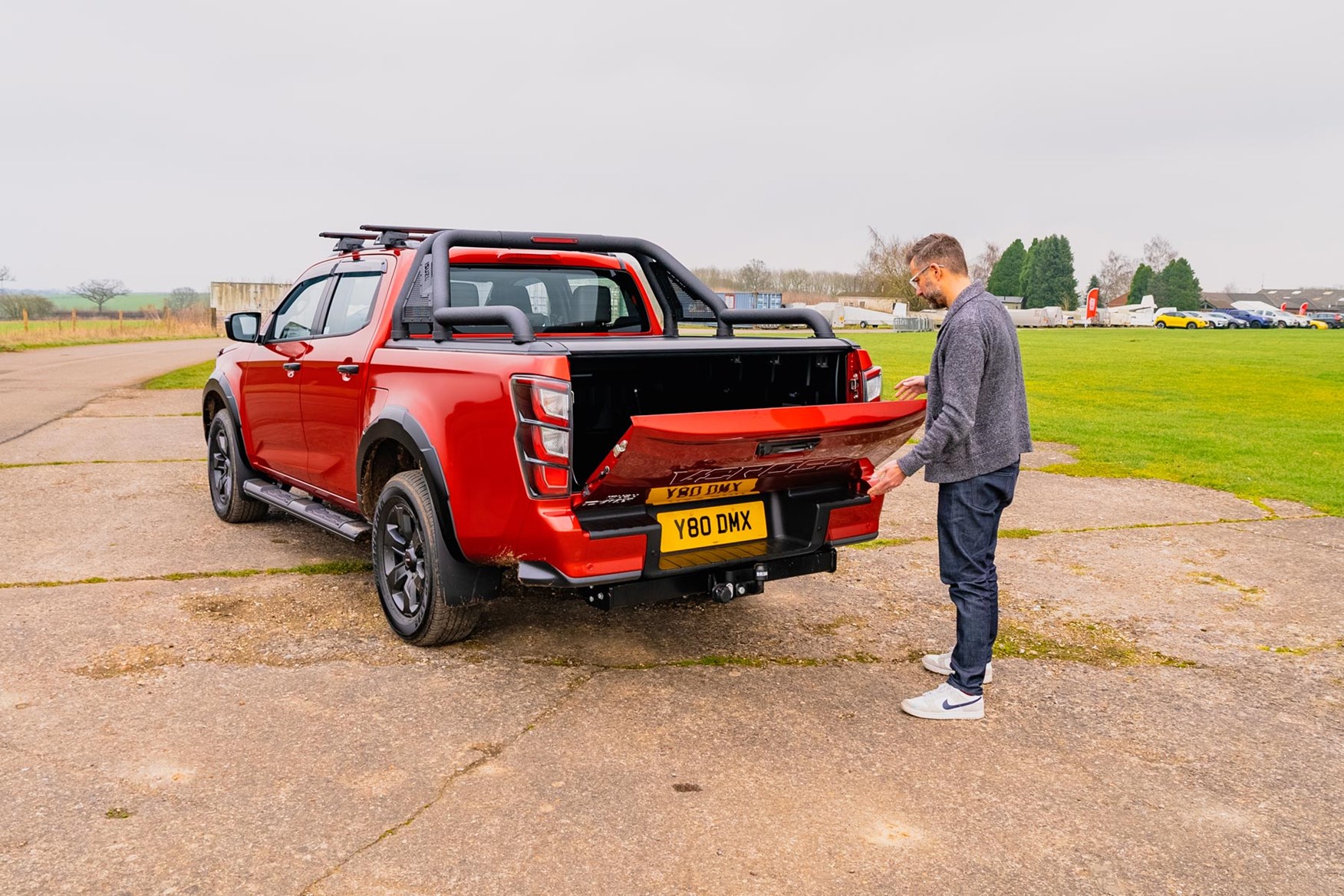
That’s equivalent to 220g/km CO2 and 241g/km CO2, respectively. The D-Max meets Euro 6D emissions regulations.
Isuzu D-Max service intervals and warranty
The service intervals for the 1.9-litre engine are one year or 12,500 miles, whichever comes sooner.
The warranty length is five years or 125,000 miles, whichever comes sooner.
Isuzu D-Max standard equipment
These are the highlight standard equipment items for each D-Max trim level.
Isuzu D-Max Utility standard equipment:
- Automatic lights and wipers
- High beam assist
- Six-way adjustable driver’s seat with lumbar support
- Height and reach adjustable steering wheel with multifunction controls
- Vinyl flooring
- Manual air-conditioning
- Bluetooth
- DAB radio
- CD player
- Front USB port
- Two speakers
- Electric windows
- Remote locking
- Unpainted bumpers, door mirrors and door handles
- Rear bumper with integrated step
- Full suite of ADAS safety equipment (detailed in Safety section below)
Isuzu D-Max DL20 standard equipment (in addition to Utility):
- Rear differential lock
- 18-inch alloy wheels
- Front foglights
- Rear parking sensors
- Medium Grey front grille
- Body coloured bumpers
- Body coloured door mirrors, heated and folding
- Silver door handles
- Four speakers
- Rear USB port (Double Cab)
- Heated front seats
- Height-adjustable head rests
- Front centre arm rest
- Carpet flooring
- Rear centre armrest with cupholders (Double Cab)
- Rear heating ducts
Isuzu D-Max DL40 standard equipment (in addition to DL20):
- Bi-LED headlights
- LED front foglights
- LED daytime running lights
- LED rear lights
- Front and rear parking sensors
- Reversing camera
- Silver side steps
- Chrome front grille, door mirrors and door handles
- Leather upholstery
- Eight-way electric driver’s seat adjustment
- Dual-zone climate control
- 7.0-inch touchscreen infotainment system with Apple CarPlay and Android Auto (and no CD player)
- Six speakers
- Keyless entry and start
- Rear ventilation panel
Isuzu D-Max V-Cross standard equipment (in addition to DL40):
- Gun metal front grille, door mirrors, door handles, side steps and alloy wheels
- Automatic headlight levelling
- 9.0-inch touchscreen infotainment system
- CD Player
- Eight speakers
- Auto-dimming rear-view mirror
- Illuminated vanity mirrors in the sunvisors
- V-Cross carpet mats
The D-Max has traditionally enjoyed an excellent reputation for reliability and durability, and that the engine has been in use since 2017 – which should hopefully mean that any teething troubles have been dealt with by now.
- A highly rated pickup according to Euro NCAP
- Huge amount of standard safety equipment on all models
- Double Cab variants get eight airbags and even more tech
With its five-star Euro NCAP rating and stacks of advanced safety kit, the Isuzu D-Max is a very safe pickup truck. The crash test rating included a maximum score for child occupant protection. 2025 brings upgraded front camera system, which can now see wider than before and see vehicles from up to 150m away. This means that the lane keep assist has been improved while the adaptive cruise control can now read traffic signs to adjust to the speed limit.
In addition to seven airbags – eight on Double Cab models – all of the following Advanced Driver Assist Systems (ADAS) are fitted as standard on every Isuzu D-Max:
- Cruise control
- Forward collision warning
- Autonomous emergency braking (AEB)
- Traffic sign recognition
- Manual and intelligent speed limiters
- Lane departure warning and prevention
- Multi-collision brake
- Emergency lane keeping
- Adaptive cruise control
- Lane keeping assist
And if it’s a Double Cab model, you also get these features as well:
- Blind spot monitor
- Rear cross traffic alert
Plus, every model comes with automatic lights and wipers, automatic high-beam assist, hill descent control, hill start assist, electronic stability control (ESC), traction control and E-Call emergency call function that automatically alerts the emergency services after an accident.
But what does that all mean?
Well, taking the curiosities on the above lists in order…
The forward collision warning system is a row of flashing red lights that go off if the D-Max thinks you’re about to hit something. It’s quite an early warning, so you should have time to take action before the AEB kicks in (we were able to test both things, and they seem to function effectively).
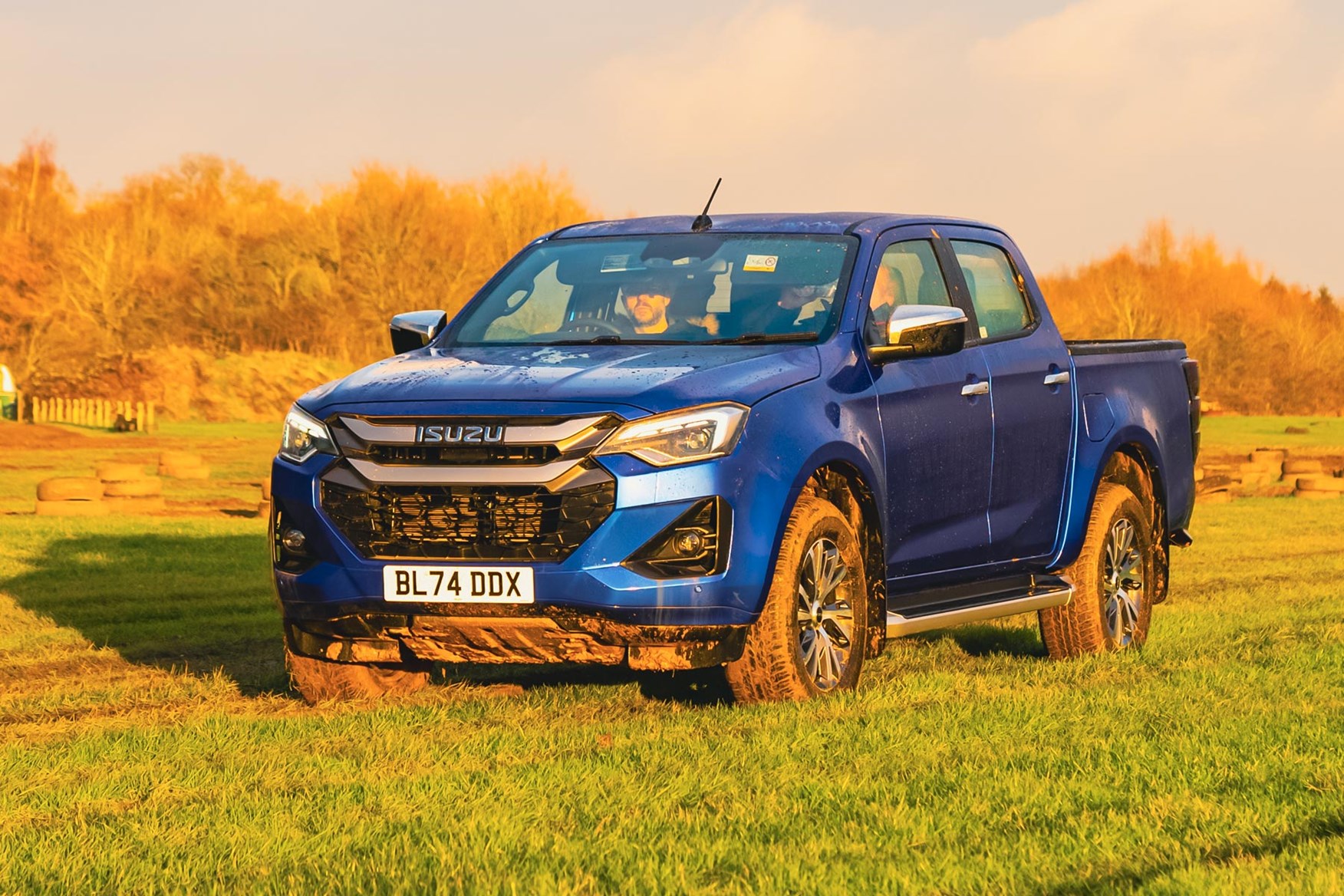
It helps that Isuzu uses a stereo camera system rather than a forward radar; this is a pair of cameras you can see at the top of the windscreen that function as the D-Max’s eyes to judge distance and spot hazards. This is said to be faster and more accurate than conventional radar systems. This has been upgraded for 2025 and is now more efficient than before.
The ‘intelligent’ speed limiter will automatically adjust the speed limited based on traffic sign information; these systems are prone to misread signs and apply the wrong limit so the improved capability is welcome.
The multi-collision brake system throws on the anchors should the airbags be deployed, reducing the chances of secondary accidents that might result if the vehicle is allowed to continue moving.
The emergency lane keeping this allows will actively prevent you from steering into another vehicle if you try to change lanes into them, something only made possible by the use of electric power steering.
There is also all the mandated audible warnings that are required these days. It's a shame that the same beep is used for everything, so it is hard to ascertain exactly what the D-Max is telling you off for at times.
Which Isuzu D-Max is best for me?
Isuzu does a lot of the thinking for you here by dividing the range into Business and All-Purpose categories – you probably already know which kind of buyer you are.
That said, the Business range is just the Utility model, and the range-topping V-Cross auto is set to be the bestseller anyway. This will still function exceptionally well as a working vehicle, so don’t just rule it out as a lifestyle accessory.
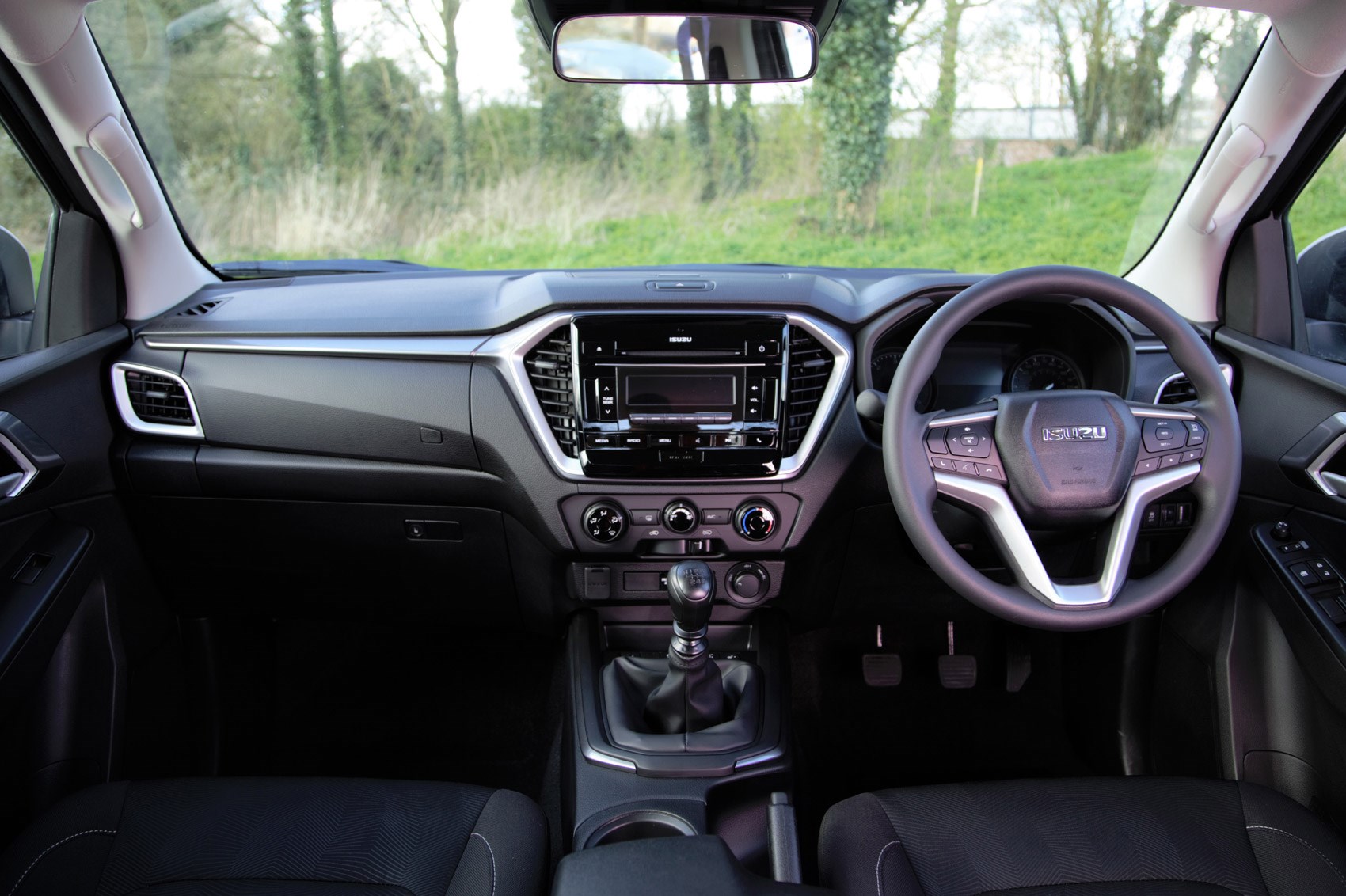
In terms of creature comforts, the biggest step-up in standard equipment comes between the DL20 and the DL40, though we have to say there are plenty of features on the DL20 that we really like – including the attractively finished fabric (rather than leather) seats.
Given how well specced the D-Max is at all levels, you almost can’t go wrong here.
Isuzu D-Max individual model reviews
We've tested loads of D-Max models over the years and here are our thoughts on them.
Isuzu D-Max Mudmaster review
Tested July 2024 by Graham King
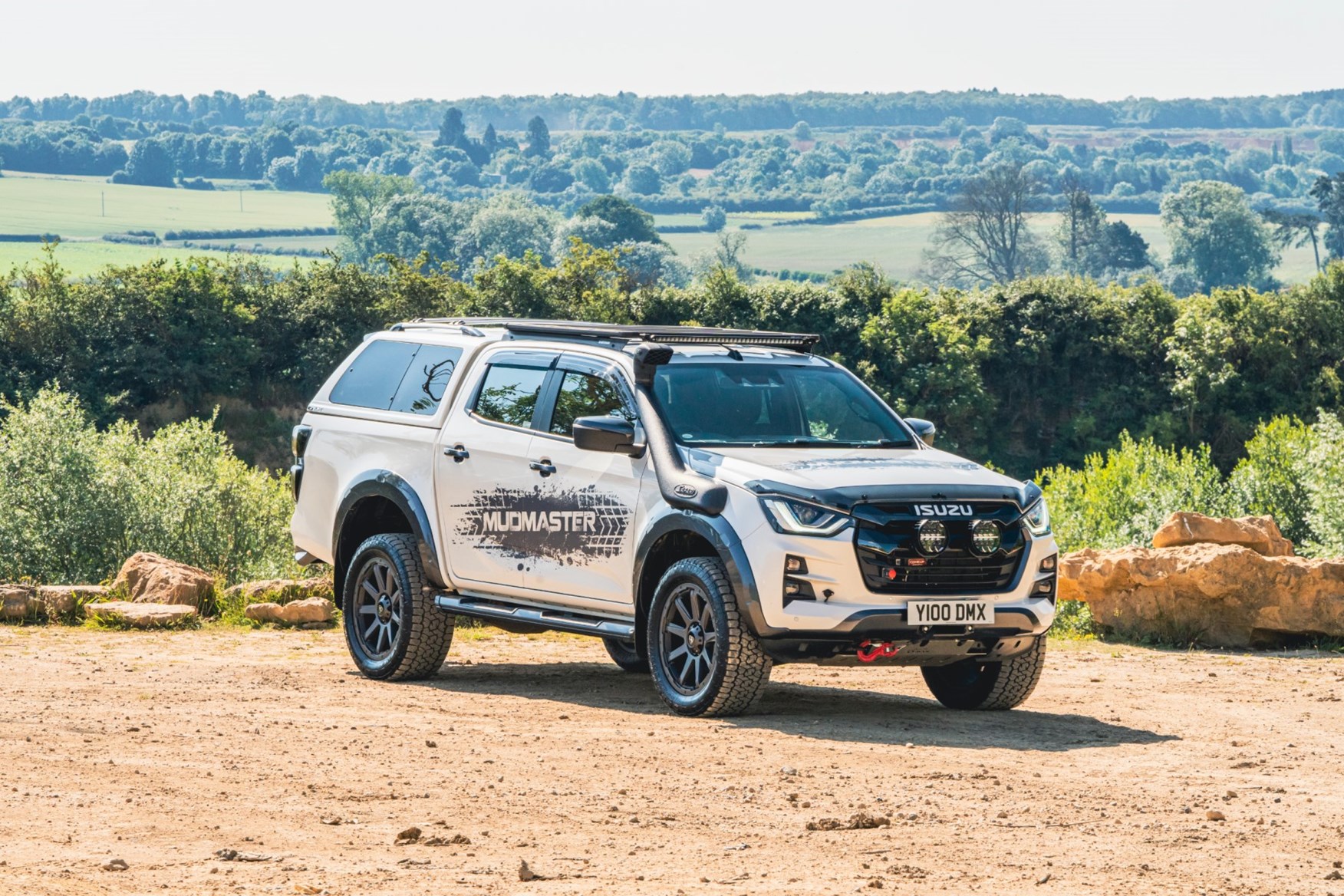
- Accessory pack geared towards serious off-roading
- Includes a winch and uprated suspension
- We give it a thorough, muddy workout
The Isuzu D-Max is a very tough, rugged pickup truck that’s often made to work very hard for its living. Not just on the road, but on building sites and farms, and that often requires tackling terrain that’s even tougher and more rugged than the D-Max.
Even in its more basic forms, the D-Max has always been an extremely capable off-roader. But Isuzu now offers an accessory pack that’s designed to really maximise that ability, marketed under the name Mudmaster.
Looking at the pictures here, you might think the Mudmaster pack is just a set of lifestyle-y trinkets that’s primarily designed to appeal to overlanding enthusiasts. It undoubtedly will, but the pack also has its uses if you’re buying a D-Max purely as a working vehicle – not least because its 1,000kg-plus payload is unaltered, so it’s still classified as a commercial vehicle.
What's included in the Mudmaster pack?
There’s an impressive list of features included in the Mudmaster pack, all of them made by market leaders in their field. Here’s what you get:
- Pedders off-road suspension kit with 1.75-inch body lift
- 20-inch Hurricane alloy wheels
- Toyo all-terrain tyres
- Winchsystems integrated winch built into the front bumper
- Steel underbody protection
- ARB Safari snorkel
- ARB cab roof rack
- Custom off-road side steps
- Lazer Linear 36 Elite lightbar
- Lazer Sentinel 7.0-inch Elite spot lamps
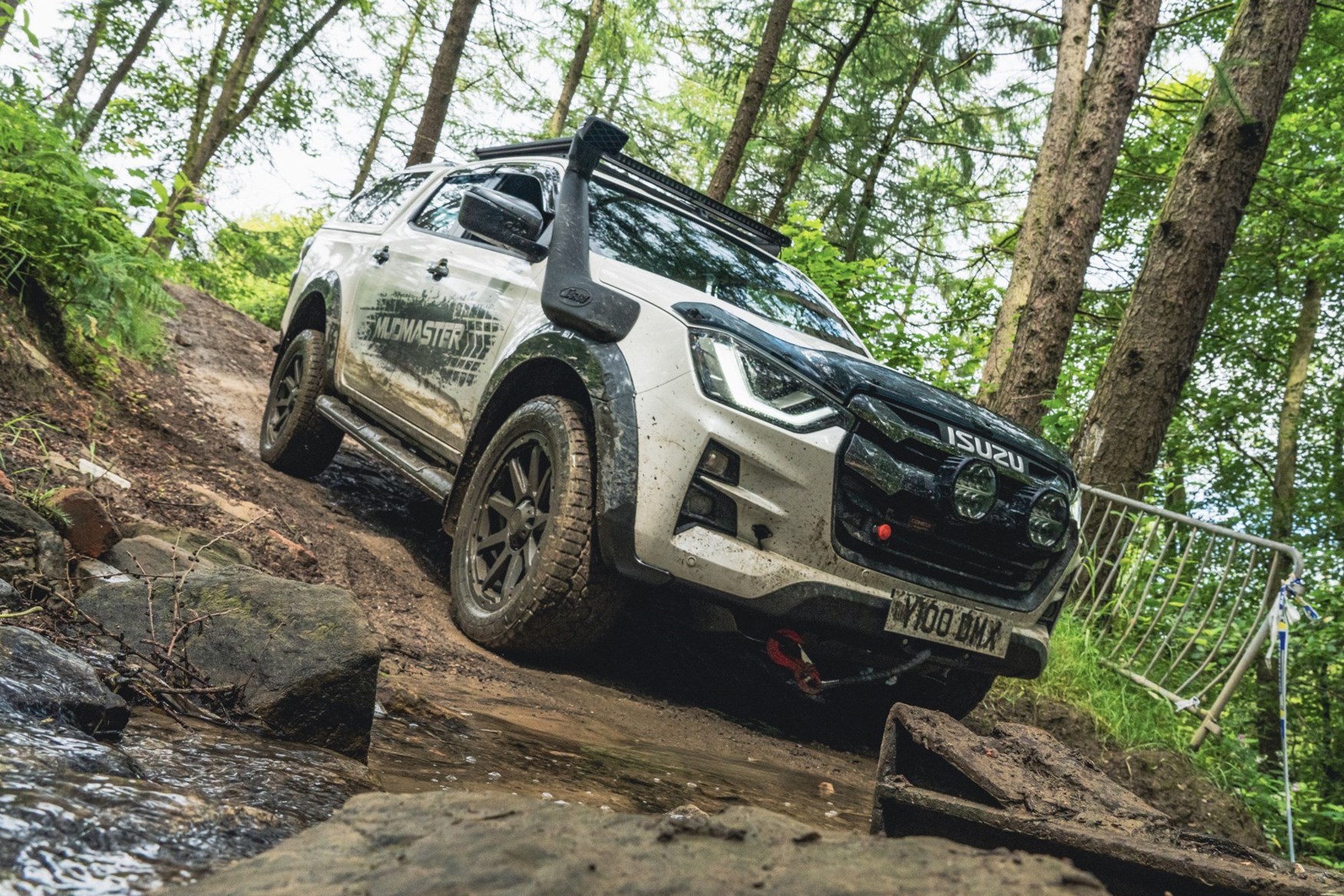
Note that each element of the Mudmaster pack is available individually from Isuzu’s extensive accessory catalogue. But combining them all into a pack saves some money off the total cost. Isuzu remained tight-lipped on what that cost is, but expect to pay around £14,000 plus VAT.
The pack is available on any D-Max model – the vehicle we tested was in top-grade V-Cross trim which also had an Alpha XS loadbed canopy and a set of Mudmaster decals.
What's it like to drive?
On first acquaintance, the Mudmaster feels pretty much exactly like any other D-Max. The lifted suspension means there’s a bit more of a climb into the cab, which is unchanged from the standard V-Cross spec of the truck we drove. Everything feels robust and hardwearing, but the V-Cross has an added layer of plushness to it.
Standard features include electrically adjustable heated leather seats, a 9.0-inch infotainment system with Apple CarPlay and Android Auto connectivity, and dual-zone climate control. The V-Cross is only available in Double Cab form, which just about has enough space for five adults. It’s certainly spacious enough for families considering switching to the D-Max from a regular car.
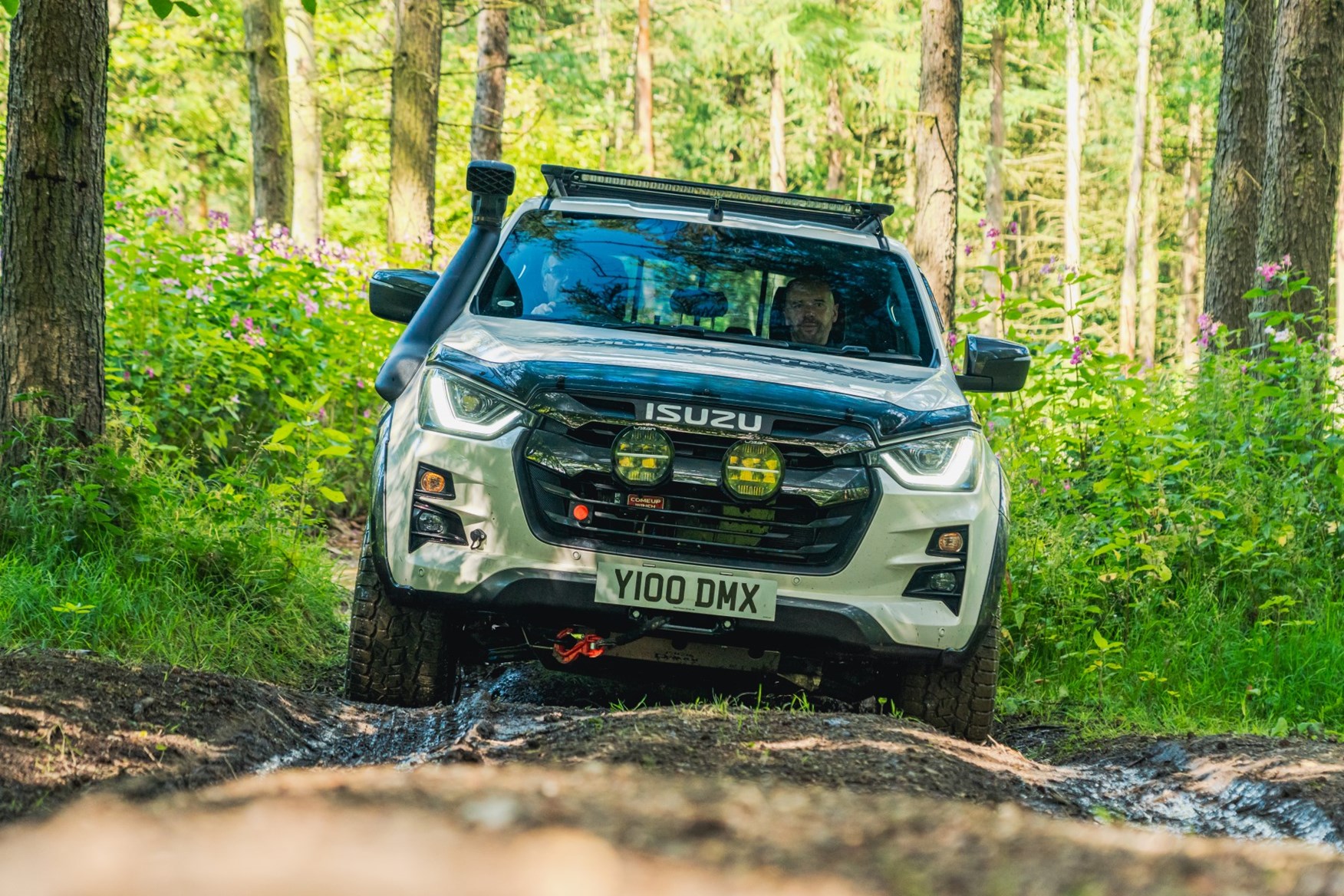
We didn’t have the opportunity to drive the Mudmaster on the road, but it should be much like any other D-Max. Expect slightly ponderous steering and a fair amount of engine noise, but it’s otherwise rather pleasant. The Mudmaster’s all-terrain tyres will likely generate more road noise than conventional rubber, but body control seemed excellent on the lifted suspension.
How capable is it off-road?
Enormously. We drove it around a very muddy off-roading centre in a Yorkshire wood filled with vicious slopes and huge rocks. We drove a standard D-Max first for comparison on a very challenging route and it barely broke sweat.
A more difficult route was picked out for the Mudmaster. There were some particularly deep holes that would have been the standard truck’s undoing, but the Mudmaster’s lifted suspension ensured it got through without incident. Similarly, the standard truck’s road tryres would have been useless on a particularly steep hill that was slick with slimy mud, but the Mudmaster’s chunky Toyo tyres dug down and found the grip to keep plugging on.
The Mudmaster also felt more robust, more up for getting down and dirty than the standard truck. We didn’t test the strength of the underbody and side sill protection – fortunately – but it seemed able to protect from extremely stout whacks. The Mudmaster is also more useful off-road than the somewhat gimmicky D-Max AT35, whose huge tyres and big lift kit add width and height that mean you can really only take the vehicle to wide open spaces.
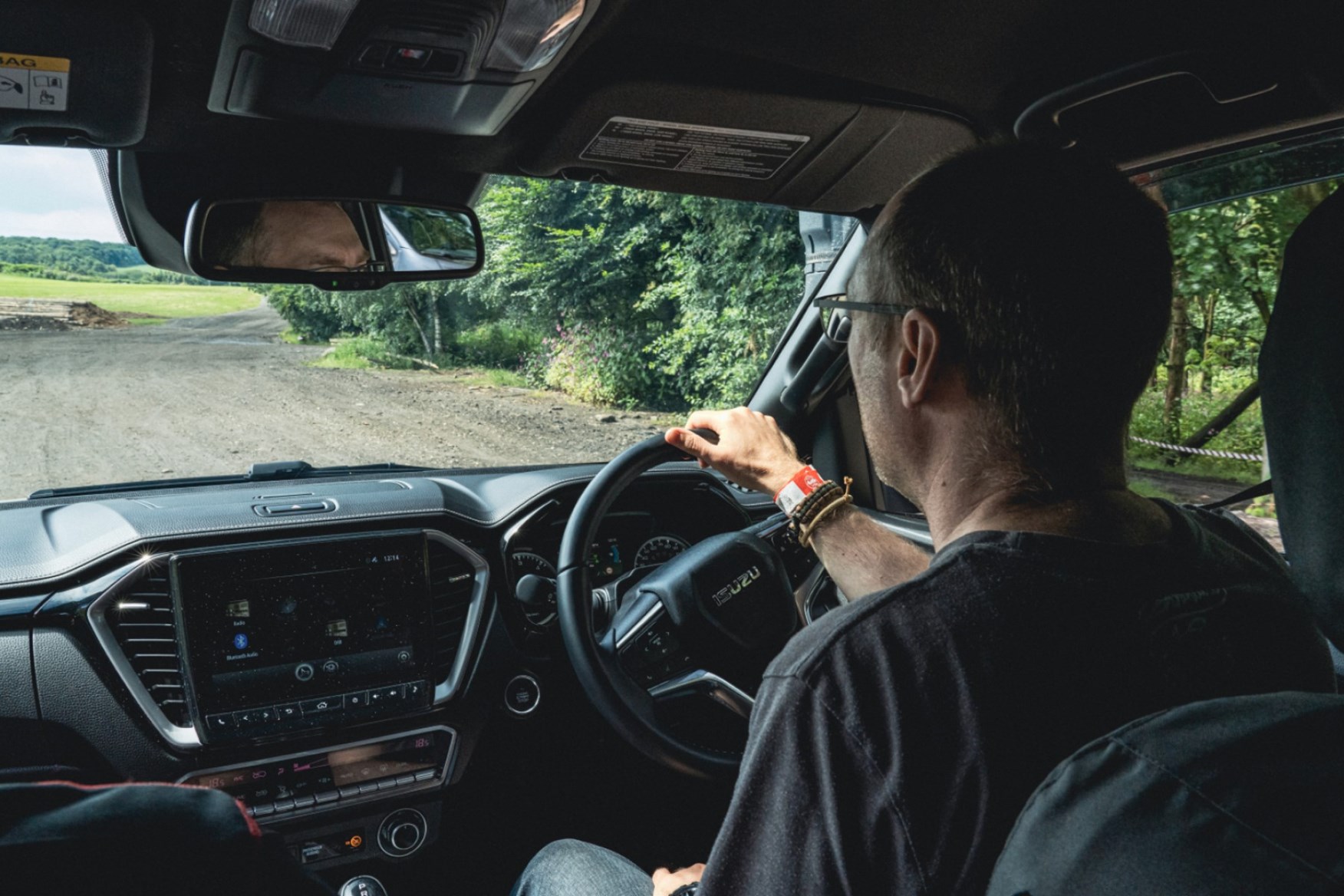
How useful are the other accessories?
It you intend to do serious off-roading the snorkel is pretty much essential. The roof rack is virtually the same length and width as the cab roof and provides useful extra carrying capacity for both work and leisure. Similarly, the extra lights are practically as bright as the sun which can often be essential on both a job site and camp site.
The single most expensive item in the Mudmaster pack is the winch – which also has the most niche appeal. But it’s 4,000kg capacity means it’s capable of hauling along even a fully laden D-Max, or rescuing a stuck mini-digger.
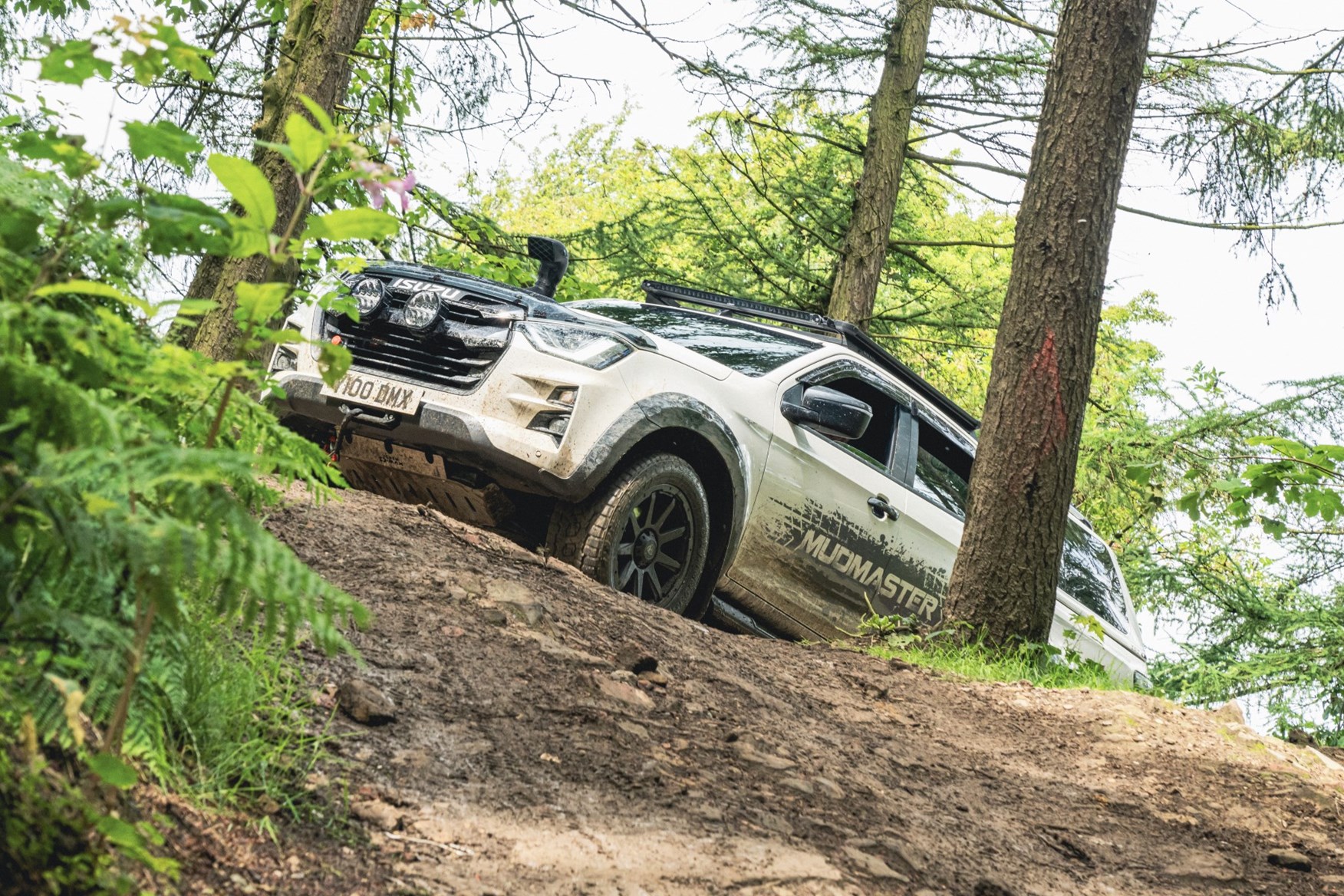
Should you buy one?
The Mudmaster pack adds appreciably to the D-Max’s off-road ability and practicality. The fully equipped truck we drove looked rather cool, as well. But the circa £14,000 plus VAT all-in cost is a very large chunk of money to add to the relatively low cost of a D-Max. The V-Cross automatic model we drove likely cost well over £60,000 once the Mudmaster pack, canopy and a few other options had been added.
We certainly get the enormous appeal of the D-Max Mudmaster, but the price makes it hard to justify as a working commercial vehicle. As a more lifestyle-orientated overlander, though, it starts to make more sense.
Isuzu D-Max AT35 Basecamp review
Tested December 2024 by Ryan Gilmore
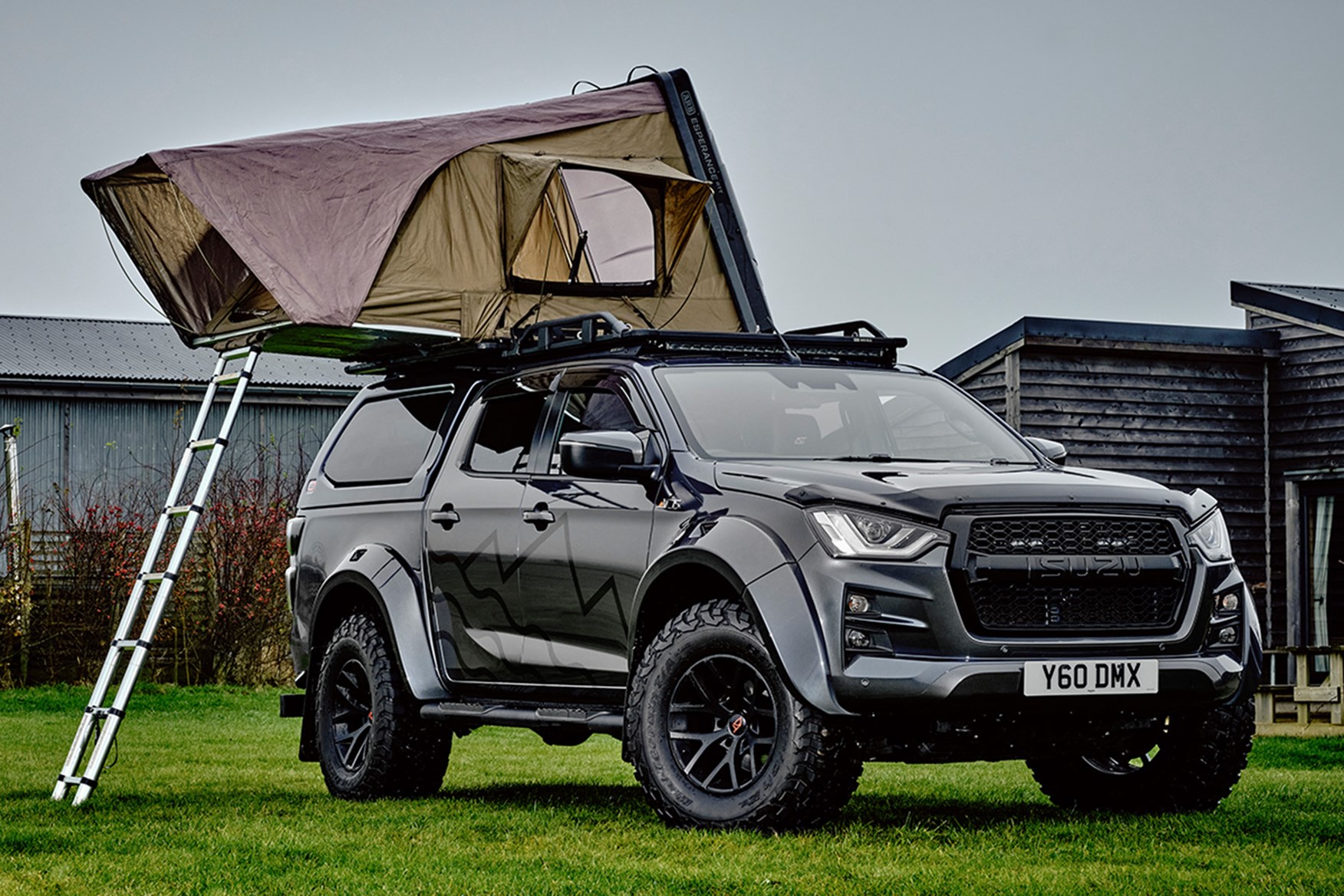
- The ultimate home-from-home Isuzu
- Modified by Arctic Trucks
- One-off model, but you can build one yourself
If the Isuzu D-Max looks appealing, but you wished it was simultaneously more and less practical, then the Basecamp edition will be right up your street.
It takes a standard Isuzu Arctic Trucks AT35, already an exceedingly capable off-roader, and adds a raft of camping accessories to make it a camper that should be able to conquer whatever terrain you can throw at it. It's big, brash and expensive. There are far more sensible choices of for remote camping, but none are as capable.
The Basecamp is a one-off so you can't pop down to a dealer and pick on up. That being said, the components that turn the AT35 into the Basecamp are all available to buy, so its possible to build one yourself.
What’s included with the Basecamp?
Almost every conceivable off-roading and camping accessory you can think of, and yes that includes a 12-litre collapsible kitchen sink. Here’s the list:
- ARB Esperance rooftop tent with hardshell
- ARB Ascent hardtop canopy
- ARB Outback Solutions modular roller drawer system
- ARB Base Rack system
- ARB Zero Fridge Freezer
- Arctic Trucks AT35 Modifications (Bilstein suspension & BFGoodrich Mud-Terrain tyres)
- Underbody Armour
- Lazer Linear 6 Elite Lamps
What’s it like to drive?
Its surprisingly easy to live with. Despite the macho exterior, the Basecamp offers a surprisingly plush interior. The interior is unchanged from the AT35 edition, which means you get electrically adjustable heated leather seats and a 9.0-inch infotainment system with Android Auto and Apple CarPlay connectivity, as well as plenty of room in the double cab. It’s fairly comfortable too. The Bilstein dampers absorb the worst of road surfaces without making the car feel wayward.
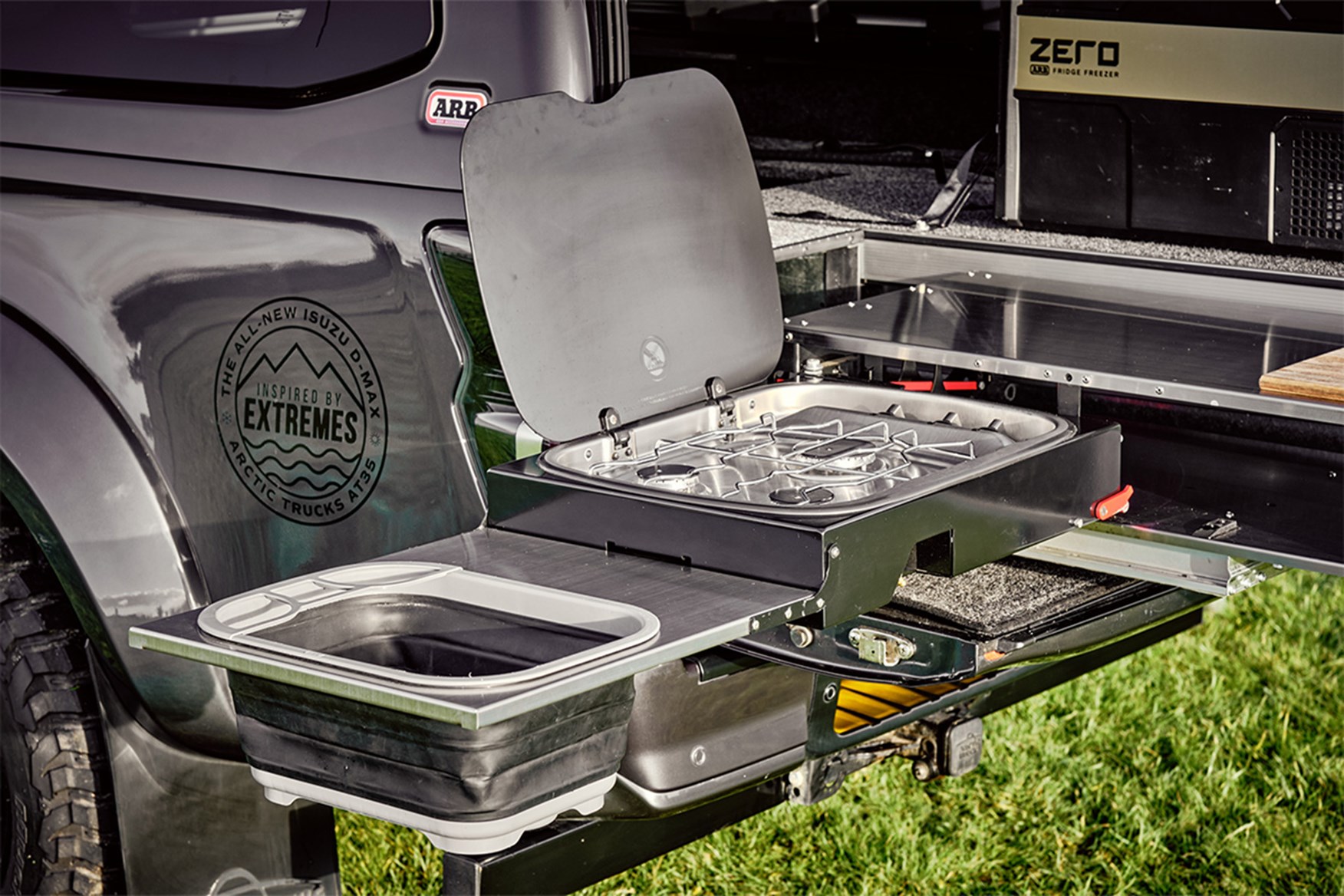
The diesel engine roars a fair bit, especially under heavy acceleration. It sounds slightly agricultural but quickly settles at cruising speeds. That’s when the drone from those mud-plunging tyres take over a minor assault on your eardrums. But it's not as unsophisticated as you'd first expect from inspecting the tyres.
The D-Max is already a big base for modification, so any extra bulk doesn’t really affect how it drives. Besides, you’re not likely to push the D-Max. I was unable to take the D-Max off road, but it should be just as capable as the D-Max Mudmaster above - the Basecamp is only missing the winch and snorkel.
Can you camp in it?
Quite easily, although the late-November test schedule prevented me from spending the night in Casa El Basecamp. The roof tent erects fairly quickly, although you'll need to make use of the side steps to get access. The awning, with it's tent like tubing is a bit more of a faff to set up, but any veteran camper will have it up in a jiffy.
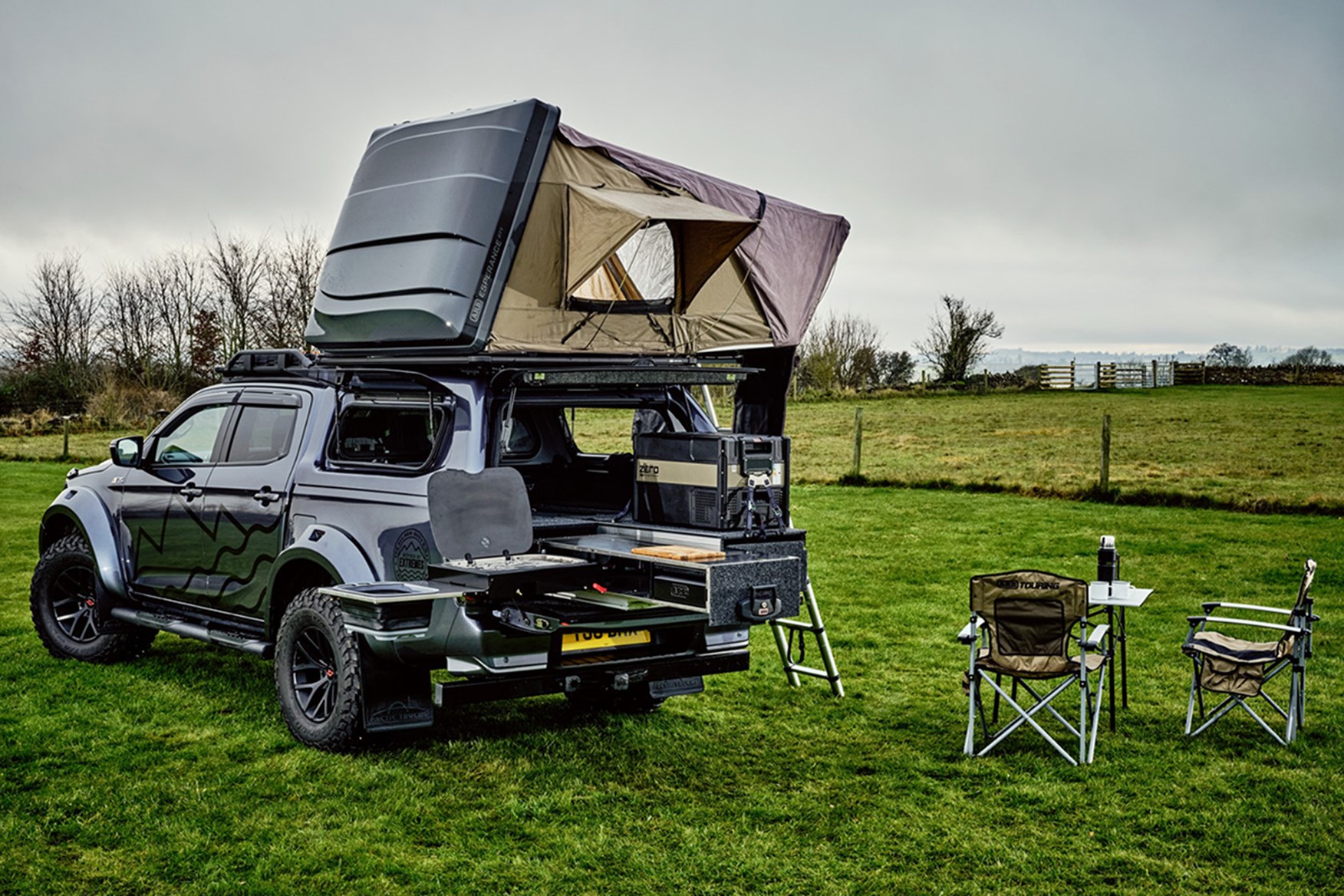
The ARB pull-out drawers are a real highlight. Not only do they feel indestructible, but the combination of a three ring gas hob, sink and generous preparation area make cooking a breeze. The two drawers fitted to the Basecamp did eat up the bed load, but the second drawer could at least be used as a super-secure way of keeping smaller items stored. The drawers cost a whopping £4,942.60 so it's a good job they're so good. That's before you add the cost of the fridge too.
Should you buy one?
The Basecamp is a one-off model, but it does showcase how capable the Isuzu D-Max AT35 is. If you're after the ultimate base for a camper, this proves the D-Max isn't a bad choice. An AT35 edition D-Max starts at £52,495 and a lot more in aftermarket accessories to make it into a replica Basecamp. Remember too, these modifications eat storage space so it's worth as a utility vehicle will be severely compromised. As a money-no-object purchase it's fantastic, but there's a reason it's not going into production.























































